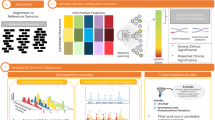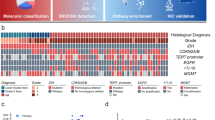Abstract
Pilocytic astrocytomas (PAs, WHO grade I) are the most common brain tumors in the pediatric and adolescent population, accounting for approximately one-fifth of central nervous system tumors. Because few consistent molecular alterations have been identified in PAs compared to higher grade gliomas, we performed array comparative genomic hybridization using two independent commercial array platforms. Although whole chromosomal gains and losses were not observed, a 1-Mb amplified region of 7q34 was detected in multiple patient samples using both array platforms. Copy-number gain was confirmed in an independent tumor sample set by quantitative PCR, and this amplification was correlated to both increased mRNA and protein expression of HIPK2, a homeobox-interacting protein kinase associated with malignancy, contained within this locus. Furthermore, overexpression of wild-type HIPK2, but not a kinase-inactive mutant, in a glioma cell line conferred a growth advantage in vitro. Collectively, these results illustrate the power and necessity of implementing high-resolution, multiple-platform genomic analyses to discover small and subtle, but functionally significant, genomic alterations associated with low-grade tumor formation and growth.
This is a preview of subscription content, access via your institution
Access options
Subscribe to this journal
Receive 50 print issues and online access
$259.00 per year
only $5.18 per issue
Buy this article
- Purchase on Springer Link
- Instant access to full article PDF
Prices may be subject to local taxes which are calculated during checkout




Similar content being viewed by others
References
Agamanolis DP, Malone JM . (1995). Chromosomal abnormalities in 47 pediatric brain tumors. Cancer Genet Cytogenet 81: 125–134.
Albertson DG . (2006). Gene amplification in cancer. Trends Genet 22: 447–455.
Arjona D, Rey JA, Taylor SM . (2006). Early genetic changes involved in low-grade astrocytic tumor development. Curr Mol Med 6: 645–650.
Calzado MA, Renner F, Roscic A, Schmitz ML . (2007). HIPK2: a versatile switchboard regulating the transcription machinery and cell death. Cell Cycle 6: 139–143.
Cheng Y, Pang JC, Ng HK, Ding M, Zhang SF, Zheng J et al. (2000). Pilocytic astrocytomas do not show most of the genetic changes commonly seen in diffuse astrocytomas. Histopathology 37: 437–444.
D'Orazi G, Cecchinelli B, Bruno T, Manni I, Higashimoto Y, Saito S et al. (2002). Homeodomain-interacting protein kinase-2 phosphorylates p53 at Ser 46 and mediates apoptosis. Nat Cell Biol 4: 11–19.
Harada J, Kokura K, Kanei-Ishii C, Nomura T, Khan MM, Kim Y et al. (2003). Requirement of the co-repressor homeodomain-interacting protein kinase 2 for ski-mediated inhibition of bone morphogenetic protein-induced transcriptional activation. J Biol Chem 278: 38998–39005.
Hayes VM, Dirven CM, Dam A, Verlind E, Molenaar WM, Mooij JJ et al. (1999). High frequency of TP53 mutations in juvenile pilocytic astrocytomas indicates role of TP53 in the development of these tumors. Brain Pathol 9: 463–467.
Ishii N, Sawamura Y, Tada M, Daub DM, Janzer RC, Meagher-Villemure M et al. (1998). Absence of p53 gene mutations in a tumor panel representative of pilocytic astrocytoma diversity using a p53 functional assay. Int J Cancer 76: 797–800.
Jenkins RB, Kimmel DW, Moertel CA, Schultz CG, Scheithauer BW, Kelly PJ et al. (1989). A cytogenetic study of 53 human gliomas. Cancer Genet Cytogenet 39: 253–279.
Jones DT, Ichimura K, Liu L, Pearson DM, Plant K, Collins VP . (2006). Genomic analysis of pilocytic astrocytomas at 0.97 Mb resolution shows an increasing tendency toward chromosomal copy number change with age. J Neuropathol Exp Neurol 65: 1049–1058.
Kim YH, Choi CY, Lee SJ, Conti MA, Kim Y . (1998). Homeodomain-interacting protein kinases, a novel family of co-repressors for homeodomain transcription factors. J Biol Chem 273: 25875–25879.
Konigshoff M, Wilhelm J, Bohle RM, Pingoud A, Hahn M . (2003). HER-2/neu gene copy number quantified by real-time PCR: comparison of gene amplification, heterozygosity, and immunohistochemical status in breast cancer tissue. Clin Chem 49: 219–229.
Koschny R, Koschny T, Froster UG, Krupp W, Zuber MA . (2002). Comparative genomic hybridization in glioma: a meta-analysis of 509 cases. Cancer Genet Cytogenet 135: 147–159.
Lin M, Wei LJ, Sellers WR, Lieberfarb M, Wong WH, Li C . (2004). dChipSNP: significance curve and clustering of SNP-array-based loss-of-heterozygosity data. Bioinformatics 20: 1233–1240.
Nannya Y, Sanada M, Nakazaki K, Hosoya N, Wang L, Hangaishi A et al. (2005). A robust algorithm for copy number detection using high-density oligonucleotide single nucleotide polymorphism genotyping arrays. Cancer Res 65: 6071–6079.
Ohgaki H . (2005). Genetic pathways to glioblastomas. Neuropathology 25: 1–7.
Ohgaki H, Dessen P, Jourde B, Horstmann S, Nishikawa T, Di Patre PL et al. (2004). Genetic pathways to glioblastoma: a population-based study. Cancer Res 64: 6892–6899.
Pierantoni GM, Bulfone A, Pentimalli F, Fedele M, Iuliano R, Santoro M et al. (2002). The homeodomain-interacting protein kinase 2 gene is expressed late in embryogenesis and preferentially in retina, muscle, and neural tissues. Biochem Biophys Res Commun 290: 942–947.
Sanoudou D, Tingby O, Ferguson-Smith MA, Collins VP, Coleman N . (2000). Analysis of pilocytic astrocytoma by comparative genomic hybridization. Br J Cancer 82: 1218–1222.
Schmidt MC, Antweiler S, Urban N, Mueller W, Kuklik A, Meyer-Puttlitz B et al. (2002). Impact of genotype and morphology on the prognosis of glioblastoma. J Neuropathol Exp Neurol 61: 321–328.
Sebat J, Lakshmi B, Troge J, Alexander J, Young J, Lundin P et al. (2004). Large-scale copy number polymorphism in the human genome. Science 305: 525–528.
Sharma MK, Watson MA, Lyman M, Perry A, Aldape KD, Deak F et al. (2006). Matrilin-2 expression distinguishes clinically relevant subsets of pilocytic astrocytoma. Neurology 66: 127–130.
Tada K, Kochi M, Saya H, Kuratsu J, Shiraishi S, Kamiryo T et al. (2003). Preliminary observations on genetic alterations in pilocytic astrocytomas associated with neurofibromatosis 1. Neuro Oncol 5: 228–234.
Thiel G, Losanowa T, Kintzel D, Nisch G, Martin H, Vorpahl K et al. (1992). Karyotypes in 90 human gliomas. Cancer Genet Cytogenet 58: 109–120.
Venkatraman ES, Olshen AB . (2007). A faster circular binary segmentation algorithm for the analysis of array CGH data. Bioinformatics 23: 657–663.
von Deimling A, Fimmers R, Schmidt MC, Bender B, Fassbender F, Nagel J et al. (2000). Comprehensive allelotype and genetic anaysis of 466 human nervous system tumors. J Neuropathol Exp Neurol 59: 544–558.
Wei G, Ku S, Ma GK, Saito S, Tang AA, Zhang J et al. (2007). HIPK2 represses beta-catenin-mediated transcription, epidermal stem cell expansion, and skin tumorigenesis. Proc Natl Acad Sci USA 104: 13040–13045.
Wemmert S, Romeike BF, Ketter R, Steudel WI, Zang KD, Urbschat S . (2006). Intratumoral genetic heterogeneity in pilocytic astrocytomas revealed by CGH-analysis of microdissected tumor cells and FISH on tumor tissue sections. Int J Oncol 28: 353–360.
White FV, Anthony DC, Yunis EJ, Tarbell NJ, Scott RM, Schofield DE . (1995). Nonrandom chromosomal gains in pilocytic astrocytomas of childhood. Hum Pathol 26: 979–986.
Wiggins AK, Wei G, Doxakis E, Wong C, Tang AA, Zang K et al. (2004). Interaction of Brn3a and HIPK2 mediates transcriptional repression of sensory neuron survival. J Cell Biol 167: 257–267.
Zattara-Cannoni H, Gambarelli D, Lena G, Dufour H, Choux M, Grisoli F et al. (1998). Are juvenile pilocytic astrocytomas benign tumors? A cytogenetic study in 24 cases. Cancer Genet Cytogenet 104: 157–160.
Zhang J, Pho V, Bonasera SJ, Holtzman J, Tang AT, Hellmuth J et al. (2007). Essential function of HIPK2 in TGFbeta-dependent survival of midbrain dopamine neurons. Nat Neurosci 10: 77–86.
Acknowledgements
HIPK2 plasmids were generously provided by Dr Gabriella D'Orazi (Regina Elena Cancer Institute, Rome Italy).
Author information
Authors and Affiliations
Corresponding authors
Additional information
Supplementary Information accompanies the paper on the Oncogene website (http://www.nature.com/onc).
Rights and permissions
About this article
Cite this article
Deshmukh, H., Yeh, T., Yu, J. et al. High-resolution, dual-platform aCGH analysis reveals frequent HIPK2 amplification and increased expression in pilocytic astrocytomas. Oncogene 27, 4745–4751 (2008). https://doi.org/10.1038/onc.2008.110
Received:
Revised:
Accepted:
Published:
Issue Date:
DOI: https://doi.org/10.1038/onc.2008.110
Keywords
This article is cited by
-
Pediatric low-grade glioma in the era of molecular diagnostics
Acta Neuropathologica Communications (2020)
-
Overexpression of homeodomain-interacting protein kinase 2 (HIPK2) attenuates sepsis-mediated liver injury by restoring autophagy
Cell Death & Disease (2018)
-
Crosstalk between NRF2 and HIPK2 shapes cytoprotective responses
Oncogene (2017)
-
Review of low-grade gliomas in children—evolving molecular era and therapeutic insights
Child's Nervous System (2015)
-
Gamma Knife treatment of low-grade gliomas in children
Child's Nervous System (2015)



